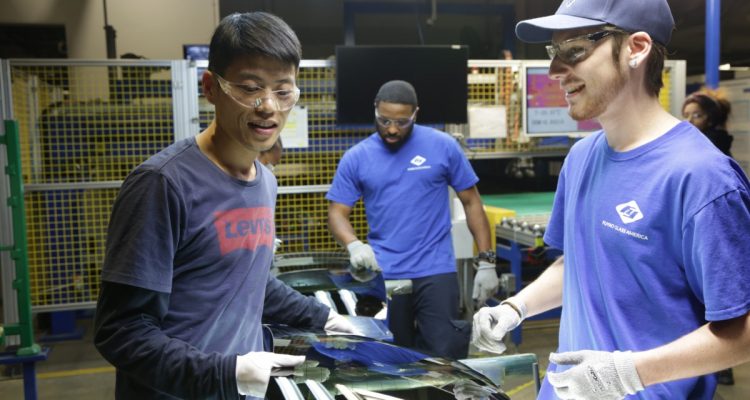The history of Netflix’s documentary “American Factory,” co-directed by Academy Award-nominated filmmakers Steven Bognar and Julia Reichert is quite fascinating. The pair have long been interested in working-class stories about the average U.S. citizen, but when Cao Dewang, CEO and Chairman of Fuyao Glass, expressed his desire to commission a film that would commemorate the milestone of his new facility, the directing duo were provided a means of exploring the everyday conditions of middle-class existence through a national prism’s outside perspective. The veteran documentarians weren’t interested in making a propaganda piece for Fuyao but saw a unique opportunity to record a significant human milestone in cross-cultural symbiosis.
“American Factory” follows the story of Fuyao Glass’ takeover of a General Motors factory that closed as a result of the 2008 recession. In a single day, close to 2,500 employees lost their jobs at just one location on the outskirts of Dayton, Ohio. When the factory re-opened, poised to be the new headquarters of the Chinese company, a culture clash surrounding the difference in workplace conditions and labor habits quickly became apparent.
Being the largest manufacturer of automotive glass in the world, Fuyao had operated major facilities in countries outside of China for years. When Ohio offered an especially generous tax credit, Chairman Cao saw a greater chance for global cooperation. Recognizing the media draw of allowing a pair of acclaimed filmmakers to document an accurate representation of the company, Cao permitted their crew to shoot day-to-day factory floor operations with a fly-on-the-wall, cinema verité-like approach, examining the differences between the Chinese and the American laborer as they learn to work together in harmony.
Watching “American Factory” is like watching an exercise in reverse globalization. To be sure that they were representing all perspectives accurately, Bognar and Reichert brought a pair of young, bilingual Chinese filmmakers (Mijie Li and Yiqian Zhang) onboard, allowing for more intimate communication with a wide array of talking head subjects. Contrasting the everyday American experience with China’s more strenuous labor standards, the film follows employees from both countries — forklift operators, local Ohio executives, stock shareholders, and more — in attempting to paint a complete picture of Fuyao’s inner workings. The information is all very interesting, and the narrative is inspiring at points, but the doc never settles on a firm thematic viewpoint and lacks a clear perspective.
When focusing on specific interactions — on isolated incidents and interpersonal relationships — the film is quite successful, but just like the CEO of Fuyao, the film places efficiency above all else. One elongated sequence, where a group of the Ohio facilities best employees takes a work trip to a factory in China, stands out as the doc’s highlight. We see Americans witnessing firsthand just how easy they have it, comparatively; their rules are not as rigid, they don’t have to line up for roll call, they work fewer hours to have more time off. After the tour, the U.S. tourists put on a YMCA dance for their hosts, offering them a window into their own culture. The world may be divided, but two nations can still feel a part of the same whole. After returning home, the U.S. workers begin implementing some of Fuyao’s teachings. “American Factory” would have benefited from spotlighting these types of company situations more.
“American Factory,” is respectably layered, but sometimes undercuts its own agenda in attempting to elicit empathy out of nearly every subject. The documentary celebrates Cao’s vision after also firmly establishing his anti-union policies. Quality of product is more important than employee safety to Fuyao and there is a significantly greater risk of injury under such conditions. Conversely, the ideological viewpoint that the film stands behind becomes difficult to distinguish.
If you were to ask a Chinese employee of Fuyao Glass Industry Group their thoughts on American work ethic they might scoff upon hearing some of the complaints. From their perspective, U.S. citizens are showered with encouragement, grow up to be over-confident and expect too much gratitude from others. As many of them see it, Americans are fortunate enough to get eight days off a month and only work eight-hour days, to begin with. When an expensive piece of glass falls off a forklift and shatters, both sides begin pointing fingers back and forth at one another. Rather than find a solution to the problem they’re each determined to find out who’s in the wrong.
Self-improvement and labor intensity are not the same thing though. Bognar and Reichert’s project is prone to muddy such conflicts and is not entirely successful in spelling out its life and death consequences. The work is emotionally instructive but thematically unfocused. Despite having a fascinating story to tell and some illuminating subjects, “American Factory” comes off as slightly over-zealous, educationally speaking, and is without a manageable sense of moral edification as an observational documentary. [B-]

